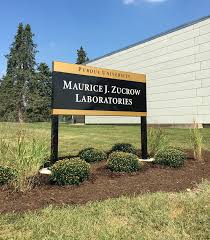Graphene is form of carbon where a single layer of carbon atoms is laid out in a hexagonal grid. Graphene has many amazing properties. It is the strongest material ever tested. It can conduct electricity and heat efficiently. It is almost transparent and yet it is surprisingly opaque for a material that is only a single atom thick. Graphene has a large and nonlinear diamagnetism and can be levitated by neodymium magnets. Although graphene has been produced for use in graphite applications such as pencils for centuries, it was isolated and characterized by researchers at the University of Manchester in 2004.
Graphene foam is created by vapor deposition on a metal foam, a three-dimensional mesh of metal filaments which are then removed, leaving a foam structure composed of graphene. Graphene foams have found use in electrodes for very efficient batteries.
Purdue University's Maurice J. Zucrow Laboratories is the largest academic propulsion lab in the world. Li Qiao is an associate professor of aeronautics and astronautics in Purdue’s College of Engineering. His team is working on a new solid propellant based on graphene foam for use in rocket engines. Their goal was to increase the burn rate of the solid fuel. Li said, “Our propulsion and physics researchers came together to focus on a material that has not previously been used in rocket propulsion, and it is demonstrating strong results.”
Li’s team is researching methods of creating and using composites that consist of conductive highly porous graphene foams loaded with solid fuels. The foams enhance the burn rate for the solid fuels that have been loaded into the foam. The team had a goal of maximizing the catalytic effect of metal oxides additives that are commonly used in solid propellants in order to facilitate decomposition. Their foam structures are thermally stable at high temperatures and can be reused by reloading solid fuel into the foam to replace the fuel that has burned.
The graphene foam works very well for solid propellants because it is extremely lightweight and highly porous. This mean that it has many holes in which engineers can load fuels to ignite a rocket launch. The foam has a 3D interconnected structure which allows for a more efficient thermal transport pathway. This allows heat to spread quickly to ignite the propellant loaded into the foam.
Li Qiao said that “Our patented technology provides higher performance that is especially important when looking at areas such as hypersonics. Our tests showed a burn rate enhancement of nine times the normal, using functionalized graphene foam structures.” Li Qiao says that the Purdue graphene foam research has applications for energy conversion devices and missile defense systems. There also other areas where tailoring nanomaterials for specific purposes can very useful.
Li Qiao and his team are working with the Purdue Research Foundation Office of Technological Commercialization (OTC) in order to patent the new technologies they have developed. They are currently seeking partners to license the new technology. The OTC “operates one of the most comprehensive technology transfer programs among leading research universities in the U.S. Services provided by this office support the economic development initiatives of Purdue University and benefit the university's academic activities.”
